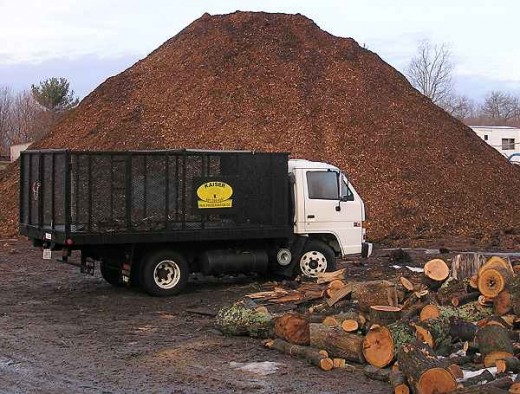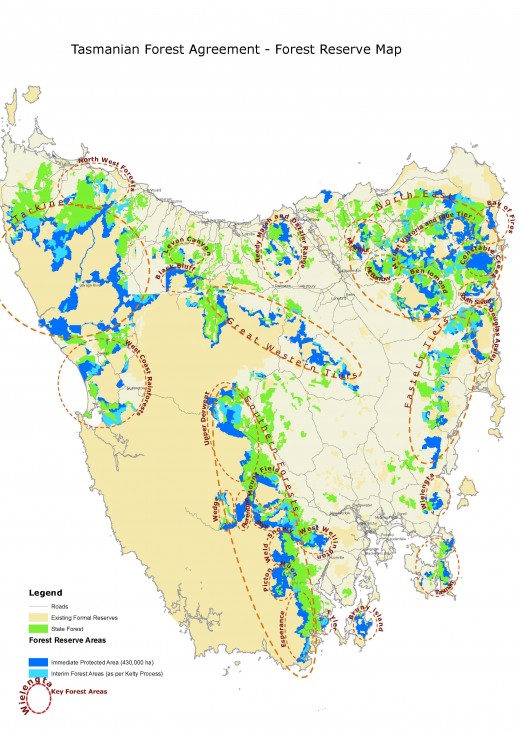Tasmanians’ chance for generational change
Friday, September 9th, 2011At a time when the Tasmanian Government has a protracted budget crisis, when Gunns and its logging venture is on the brink of financial collapse, and the Australian Federal Government is offering a $276 million package to the Tasmanian logging industry to transition out of subsidy-dependent logging; this is a time for strategic decision making. This is a time for considering the next generation of Tasmanians.
The days of governments providing subsidies to forestry are numbered. The writing is on the wall for multi-national/industrial hardwood forestry in Tasmania.
Despite the less than perfect negotiations, the undemocratic secrecy of the deal making, State and Federal governments’ poor grasp of change management, Tasmanians are presented with an olive branch. The last time a middle-ground opportunity was available to the two warring sides was the 1989 Salamanca Agreement which was quickly scuttled by government. A generation later, a considerable financial incentive and the facilitation of transition out of logging are on the table.
Irreplaceable old growth forest ecosystems are at stake, but equally at stake are rural livelihoods. There are structural social repercussions that will last decades. But then Tasmania’s poverty is already structural. It has become inter-generational and Tasmanians need a transitional direction out of poverty. While mindful of the recurring history of conflict and community polarisation, this current opportunity for change is rare and perhaps a once in a generation one at that.
In order to begin to appreciate the cultural depth of Tasmania’s ‘age-old conflict‘, at least four particular books should be read on this history:
- ‘The South West Book: A Tasmanian Wilderness‘, compiled by Helen Gee,Janet Fenton and Greg Hodge in 1978, published by William Collins Pty Lts and The Australian Conservation Foundation [Read More]
- Helen Gee’s 2001 book ‘For the Forests: A History of the Tasmanian Forest Campaigns‘, published by The Wilderness Society, Inc. [Read More]
- Greg Buckman’s 2008 book ‘Tasmania’s Wilderness Battles: a history‘, published by Allen & Unwin [Read More]
- Anna Krien’s 2010 book ‘Into the Woods: the battle for Tasmania’s Forests‘, published by Black Ink [Read More]
.
Perhaps as an interested outsider, a mainlander, I can consider this Tasmanian-wide conflict from a detached unencumbered perspective. The younger generations have opportunities that their parents and ancestors never did. Had my grandfather not died on the farm when my father was just eight years old, I may well have followed generations into sheep farming. My grandmother with her only child left the farm to give my father the best opportunity she could. I reflect on that opportunity and the greatly increased opportunity that my parents have provided me and my siblings. It takes one opportunity, for others to become available and sometimes it takes generations.
While not setting out to be critical of sheep farming per se, in hindsight sheep farming in Australia over my lifetime has become low margin and commoditised (like woodchips) and many a wool grower have not experienced the anticipated opportunities flowing on from the halcyon days when Australia was built off the sheep’s back. ‘Once a great nation-building icon, the wool business today is but a third of its size when Australia ‘rode on the sheep’s back’. Compared to the more recent Australian Wheat Board scandal, 40 times more funds were lost in the downfall, and vastly more collateral social and economic damage was done in this country and across the globe.’ Indeed, Charles Massey’s 2011 book ‘Breaking the Sheep’s Back‘ tells the untold story of the events that led to Australia’s biggest industry disaster. [Read More].
Just as Australia’s traditional wool business has declined, so too has Australia’s traditional timber business.
‘Most of the change we think we see in life is due to truths being in and out of favor.’
~ Robert Frost’s 1915 poem, ‘The Black Cottage’.
 Woodchipping Tasmania only benefits foreign buyers, who must be laughing
Woodchipping Tasmania only benefits foreign buyers, who must be laughing
.
Once island problems are recognised for what they are (internal island problems), the quicker more Tasmanian’s will recognise that the future challenges and opportunities of the island lie with industry diversification, value adding produce and services and with the world outside it. Trading internationally directly is where Tasmania’s future prosperity lies. Tasmania can learn much from the pure brand of ‘New Zealand’. Much of Tasmania’s output competes in comparable industries with the output of New Zealand.
Past and current generations of Tasmanians have become familar with old growth forests and many have become complacent of their presence. Future generations have a right to that familiarity.
Tasmanian complacency was the root cultural cause behind the eventual extinction of the Thylacene.
 Extinction is forever ~ the dark past should not curse our future
Extinction is forever ~ the dark past should not curse our future
.
“Tasmania is slowly evolving towards goals we cannot now see. If we can revise our attitudes towards the land under our feet; if we can accept a role of steward and depart from the role of conqueror; if we accept the view that man and nature are inseparable parts of a unified whole – then Tasmania can be a shining beacon in a dull, uniform and largely artificial world”.~ Olegas Truchanas, 1969
[Source: ^http://florentine.org.au/]
.
.
Intergovernmental Forests Agreement, 2011
.
In October 2010, the major breakthrough in the almost century long dispute over Tasmania’s forests was reported secured in principle between the key parties, Tasmanian timber communities, forest unions, and industry, Gunns, Environment Tasmania, the Conservation Council, The Wilderness Society, Australian Conservation Foundation. Credit is due to the two instrumental negotiators, Gunns chief executive Greg L’Estrange and forest facilitator Bill Kelty.
 Tasmanian History in the making
Tasmanian History in the making
.
The aim was to find an agreement develop a more sustainable timber industry and to end logging Tasmania’s remaining valuable native forests. It will mean an end to logging of native forests will also protect critical habitats for Tasmanian devils and other threatened species. A moratorium on the logging of high native forests will be phased in over three months, while maintaining essential supplies for necessary timber mill operations.
The “Tasmanian Forests Statement of Principles” were agreed to set Tasmania’s timber industry on a new path to economic opportunities through plantation-based forestry, protecting timber worker’s jobs and native forests.
.
>Read Tasmanian Forests Statement of Principles
.
“The forestry industry, unions and environment groups have found common ground in the interests of all Tasmanians. This will pave the way for a sustainable timber industry that protects jobs and also protects the state’s remaining unique native forests,” said Environment Tasmania’s Phill Pullinger..
.
[Source: ‘Forests: Peace in our time?’, by Andrew Darby, The Age, newspaper, 20101019, ^http://tasmaniantimes.com/index.php/article/peace-in-our-time] .>Read Tasmanian Forests Agreement – August 2011
 >Read Larger Detailed Map
>Read Larger Detailed Map
.
.
Tasmanian Transition from High Volume/Low to Low Volume/ High Value Add Timber – public debate recommended
.
While not advocating industrial logging of Tasmania’s native myrtle, a refocus from high volume/low margin woodchips toward low volume / high value specialised timbercraft is a Tasmanian industry that has potential to be both commercially viable while being ecologically sustainable, if excluding old growth and so long as it is appropriately tightly controlled and monitored.
A public debate on this potential is recommended.
 High value-add Electric Guitar in Tasmanian Myrtle
[Source: ^http://tasmaniantonewoods.com/guitars]
High value-add Electric Guitar in Tasmanian Myrtle
[Source: ^http://tasmaniantonewoods.com/guitars]
.
.
Further Reading:
.
‘Gunns rejects crucial financial offer’
.
‘Troubled forestry company Gunns has rejected a financial offer from the Tasmanian government seen as key to the future of the state’s timber industry. The settlement for exiting native forest logging was critical both to Gunns’s future operations and to a landmark forests peace settlement.
”The state government has been formally advised by Gunns Limited of their decision to reject our offer of commercial settlement,” a spokesman for Premier Lara Giddings said yesterday.
The settlement was needed to unlock funding for contractors squeezed by the exit from native forests in a $276 million federal-state package. Rejection comes with Gunns into the fifth week of a stock exchange trading halt, called for the settlement negotiations, with its share price at an all-time low of 20.5¢. The settlement, covering tens of millions of dollars, was meant to extinguish Gunns’s legal rights over native forest contracts with Forestry Tasmania.
.
.
.
‘Tasmanian Forests Agreement (official announcement)’
.[Source: The Australian Government, 2011, ^http://australia.gov.au/content/tasmanian-forests-agreement]
.
‘The Prime Minister and the Tasmanian Premier have announced a $276 million funding package to support the adjustment of the Tasmanian forestry industry, and to create a significant conservation benefit by reserving and protecting High Conservation Value native forest areas. The Tasmanian Forests Intergovernmental Agreement is designed to support the forest industry to progressively transition to a more sustainable and diversified footing and to build regional economic diversity and community resilience.
The agreement includes:
.
Support for workers, contractors and communities
- Up to $25 million to provide immediate employment and training support for redundant forest workers
- Intensive support through Job Services Australia and other providers relocation support for redundant forestry workers
- $15 million for transition support payments (through ForestWorks)
- $1 million over two years for mental health counselling and community well-being services (through Rural Alive and Well)
- $45 million for voluntary exits from public native forest operations for haulage, harvest and silvicultural contractors.
Tasmanian forest industry workers can call the Tasmanian Forest Support Information Line on 1800 648 075 for more information about the services and payments that may be available to them.
Protecting high conservation value forests and ensuring sustainable wood supply
- Guaranteed annual sustainable timber supply of at least 155,000 cubic metres of high quality sawlog per year and 265,000 cubic metres of peeler billets each year
- Provision for speciality timber, noting that the industry claim is 12,500 cubic metres per year, subject to verification funding to support an independent verification process
- Funding for a voluntary sawlog contract buy-back program for sawmillers wishing to exit the industry
- 430,000 hectares of native forest immediately placed into Informal Reserves
- Legislation no later than 30 June 2012 to formally protect the areas of reserve determined by the independent verification
- $43 million to implement this Agreement (including at least $5 million to support provision of information and consultation with affected communities)
- $7 million per year to support management of additional reserves.
Economic diversification
- $120 million over 15 years to fund regional development projects
- Development of a process to identify by mid 2012:
- the impacts of forestry adjustment on affected regions, including the scope for
- alternative sectors and jobs to support regional adjustment
- progress in implementing Commonwealth and Tasmanian adjustment measures
- the need for further regional development assistance
- A major research and analytical project to underpin this process.
.
.
‘Giddings acts to avert budget crisis’
[Source: Brand Tasmania Newsletter, March, 2011, Issue 114, ^http://www.brandtasmania.com/newsletter.php?ACT=story&issue=114&story=1] Tasmanian Premier and Treasurer, Lara Giddings
Photo courtesy of The Hobart Mercury
Tasmanian Premier and Treasurer, Lara Giddings
Photo courtesy of The Hobart Mercury
.
As unemployment figures for January showed a monthly rise from 5.0 to 5.6 %, the Premier and Treasurer, Lara Giddings, foreshadowed a 3 % cut in public sector spending and warned Tasmanians to expect three tough Budgets as the State’s balance sheet is shifted back into the black.
Releasing the Mid Year Financial Report on 10 February, Ms Giddings said several 2010 elections promises would have to be scrapped in the drive to off-set an $800 million loss of revenue. She outlined the following immediate savings:
- $97.5m cancellation of equity transfers to GBEs;
- $30.9m scrapping of planned Helicopter Emergency Medical Service;
- $18.0m shelving of proposed Cosgrove Specialist Sports School;
- $ 3.8m dropping of the Events Attraction Program;
- $ 2.0m closing down the Renewable Energy Loan Fund
- $ 3.9m deferring IT projects over two years; and
- $ 2.5m cutting ministerial and parliamentary office expenditure.
“These savings will improve the Government’s financial position in the short term while longer-term structural changes are being developed and implemented,” Ms Giddings said.
She told a media conference the savings needed were the equivalent of 2,300 jobs and she could not rule out forced redundancies in the public service, nor cuts to frontline services. Unions immediately branded her as the first Labor Premier in history to announce public service sackings.
.
“I want to be open and frank with people about the problems we are facing,” Ms Giddings said.
“We are in a place where we need to see significant action to avert a crisis. This is not a crisis; this is an unsustainable situation that will lead to a crisis if action isn’t taken now.”
.
[Editor’s note:
To the contrary, a ‘crisis‘ in a governmental context is defined by the Merriam-Webster dictionary as:
“an unstable or crucial time or state of affairs in which a decisive change is impending; especially : one with the distinct possibility of a highly undesirable outcome <a financial crisis>“]
.
The number of people on the State Government payroll has increased 24 per cent this decade to 25,000 – almost one in every nine employed Tasmanians. Economic commentator Saul Eslake has pointed out that it costs public employees 14 per cent more a year to deliver services to each citizen, compared with their counterparts in Victoria.
So the Government expects job cuts, spending cutbacks and increased efficiency in the public service to contribute $270 million of the $420 million it hopes to save over the next four years.
Ms Giddings said it was regrettable that some worthwhile Government programs could not be continued, but strong action was needed in response to falls in GST revenue and other income in the wake of the global financial crisis. “I am determined to take the steps necessary to protect the Government’s financial position,” Ms Giddings said. “While I would prefer not to have to take some of these measures, I believe they are essential if we are to avoid sliding back into net debt.”
A Sensis Business Index released in late February reinforced the need for decisive action, Ms Giddings said. “The national downturn in retail trade is a concern the State Government shares with local retailers, as it continues to directly impact upon the State budget through reduced GST receipts.”
.
[Read More].
– end of article –
.









